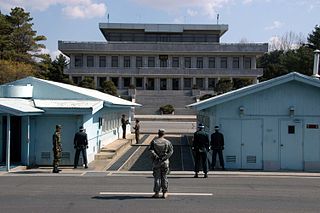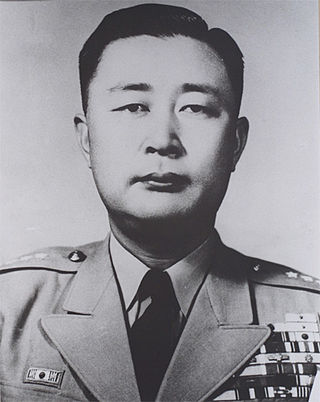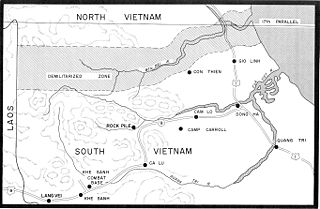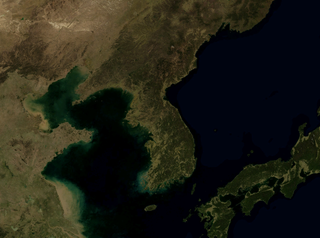Related Research Articles

The Korean War was fought between North Korea and South Korea; it began on 25 June 1950 when North Korea invaded South Korea and ceased upon an armistice on 27 July 1953. North Korea was supported by the Soviet Union and the People's Republic of China (PRC) while South Korea was supported by the United Nations Command (UNC) led by the United States (US).

Syngman Rhee was a South Korean politician who served as the first president of South Korea from 1948 to 1960. Rhee is also known by his art name Unam. Rhee was also the first and last president of the Provisional Government of the Republic of Korea from 1919 to his impeachment in 1925 and from 1947 to 1948. As president of South Korea, Rhee's government was characterised by authoritarianism, limited economic development, and in the late 1950s growing political instability and public opposition.

The Korean conflict is an ongoing conflict based on the division of Korea between North Korea and South Korea, both of which claim to be the sole legitimate government of all of Korea. During the Cold War, North Korea was backed by the Soviet Union, China, and other allies, while South Korea was backed by the United States, United Kingdom, and other Western allies.

The division of Korea began on August 15, 1945 when the official announcement of the surrender of Japan was released, thus ending the Pacific Theater of World War II. During the war, the Allied leaders had already been considering the question of Korea's future following Japan's eventual surrender in the war. The leaders reached an understanding that Korea would be liberated from Japan but would be placed under an international trusteeship until the Koreans would be deemed ready for self-rule. In the last days of the war, the United States proposed dividing the Korean peninsula into two occupation zones with the 38th parallel as the dividing line. The Soviets accepted their proposal and agreed to divide Korea.

The Korean Demilitarized Zone is a heavily militarized strip of land running across the Korean Peninsula near the 38th parallel north. The demilitarized zone (DMZ) is a border barrier that divides the peninsula roughly in half. It was established to serve as a buffer zone between the countries of North Korea and South Korea under the provisions of the Korean Armistice Agreement in 1953, an agreement between North Korea, China, and the United Nations Command.

Paik Sun-yup was a South Korean military officer. Paik is best known for his service during the Korean War, for being the first four-star general in the history of the South Korean military, and for his service as a diplomat and statesman for South Korea.

The People's Volunteer Army (PVA), officially the Chinese People's Volunteers (CPV), was the armed expeditionary forces deployed by the People's Republic of China during the Korean War. Although all units in the PVA were actually transferred from the People's Liberation Army (PLA) under the orders of Chairman Mao Zedong, the PVA was separately constituted in order to prevent an official war with the United States. The PVA entered Korea on 19 October 1950 and completely withdrew by October 1958. The nominal commander and political commissar of the PVA was Peng Dehuai before the ceasefire agreement in 1953, although both Chen Geng and Deng Hua served as the acting commander and commissar after April 1952 following Peng's illness. The initial units in the PVA included 38th, 39th, 40th, 42nd, 50th, 66th Corps; totalling 250,000 men. About 3 million Chinese civilian and military personnel had served in Korea throughout the war.

The First Republic of Korea was the government of South Korea from August 1948 to April 1960. The first republic was founded on 15 August 1948 after the transfer from the United States Army Military Government that governed South Korea since the end of Japanese rule in 1945, becoming the first independent republican government in Korea. Syngman Rhee became the first president of South Korea following the May 1948 general election, and the National Assembly in Seoul promulgated South Korea's first constitution in July, establishing a presidential system of government.

The Vietnamese Demilitarized Zone was a demilitarized zone at the 17th parallel in Quang Tri province that was the dividing line between North Vietnam and South Vietnam from 22 July 1954 to 2 July 1976, when Vietnam was officially divided into the two military gathering areas, which was supposed to be sustained in the short term after the First Indochina War.

The United States Forces Korea (USFK) is a sub-unified command of U.S. Indo-Pacific Command (USINDOPACOM). USFK is the joint headquarters for U.S. combat-ready fighting forces and components under the ROK/US Combined Forces Command (CFC) – a supreme command for all of the South Korean and U.S. ground, air, sea and special operations component commands. Major USFK elements include U.S. Eighth Army (EUSA), U.S. Air Forces Korea, U.S. Naval Forces Korea (CNFK), U.S. Marine Forces Korea (MARFORK) and U.S. Special Operations Command Korea (SOCKOR). It was established on July 1, 1957.

United Nations Command is the multinational military force established to support the Republic of Korea during and after the Korean War. It was the first international unified command in history, and the first attempt at collective security pursuant to the Charter of the United Nations.

Operation Big Switch was the repatriation of all remaining prisoners of the Korean War. Ceasefire talks had been going on between the North Korean, Chinese and United Nations Command (UNC) forces since 1951, with the main point of contention being the repatriation of all prisoners to their home countries, in accordance with Article 118 of the 1949 Geneva Convention. China and North Korea wanted prisoners to be compulsorily repatriated as outlined by the Geneva Convention but the UNC insisted that prisoners who wished to remain where they were be allowed to do so. After talks dragged on for two years, the Chinese and North Koreans relented on this point, and the Korean Armistice Agreement was signed on 27 July 1953.

Resolution 82 was adopted by the United Nations Security Council (UNSC) on 25 June 1950. It condemned the "armed attack on the Republic of Korea by forces from North Korea", while calling for "the immediate cessation of hostilities" and for "the authorities in North Korea to withdraw forthwith their armed forces to the 38th parallel". The measure was adopted with 9 voting for, none opposed, and one abstention by Yugoslavia. The Soviet Union was absent, as it was boycotting the UN at the time for its recognition of the Republic of China as China's representative to the organization.
The aftermath of the Korean War set the tone for Cold War tension between superpowers. The Korean War was important in the development of the Cold War, as it showed that the two superpowers, United States and Soviet Union, could fight a "limited war" in a third country. The "limited war" or "proxy war" strategy was a feature of conflicts such as the Vietnam War and the Soviet War in Afghanistan, as well as wars in Angola, Greece, and the Middle East.

Australia entered the Korean War on 28 September, 1950; following the invasion of South Korea by North Korea. The war's origins began after Japan's defeat in World War II, which heralded the end to 35 years of Japanese occupation of the Korean Peninsula. The surrender of Japan to the Allied forces on 2 September 1945 led to the division of Korea into two countries, which were officially called the Democratic People's Republic of Korea (DPRK) and the Republic of Korea (ROK). The DPRK were occupied by the Soviet Union, and the ROK, below the 38th Parallel, were occupied by the United States (US).

The United States Air Force in South Korea is composed of units assigned to Pacific Air Forces Seventh Air Force. The mission of the personnel, equipment and aircraft is to deter, protect and defend the Republic of Korea from attack from the Democratic People's Republic of Korea (DPRK) or more commonly known as North Korea.
The 38th parallel north is a circle of latitude that is 38 degrees north of the Earth's equatorial plane. It crosses Europe, the Mediterranean Sea, Asia, the Pacific Ocean, North America, and the Atlantic Ocean. The 38th parallel north formed the border between North and South Korea prior to the Korean War.

The Korean Armistice Agreement is an armistice that brought about a cessation of hostilities of the Korean War. It was signed by United States Army Lieutenant General William Harrison Jr. and General Mark W. Clark representing the United Nations Command (UNC), North Korea leader Kim Il Sung and General Nam Il representing the Korean People's Army (KPA), and Peng Dehuai representing the Chinese People's Volunteer Army (PVA). The armistice was signed on 27 July 1953, and was designed to "ensure a complete cessation of hostilities and of all acts of armed force in Korea until a final peaceful settlement is achieved."
The December massacres were a series of politically motivated executions carried out by the South Korean government following the recapture of Pyongyang by communist forces in the Korean War. The killings took place in South Korea, but mainly in and around Seoul. It is believed the South Korean government executed thousands of people, however accurate estimates are difficult to come by. The Rhee regime received criticism from the international community and the executions damaged his image.
The UN offensive into North Korea was a large-scale offensive in late 1950 by United Nations (UN) forces against North Korean forces during the Korean War.
References
- 1 2 3 4 5 6 7 8 As of this edit, this article uses content from "Korean War - Facts & Summary" , which is licensed in a way that permits reuse under the Creative Commons Attribution-ShareAlike 3.0 Unported License, but not under the GFDL. All relevant terms must be followed.
- ↑ "The Armed Forces in the Korean War" Archived 2017-02-16 at the Wayback Machine Retrieved October 2, 2016
- ↑ "The Korean War | 1950-1953" Retrieved October 3, 2016
- ↑ The Statistics of the Korean War - ROK Ministry of National Defense Institute for Military History, 2014 (E-BOOK) Archived 2023-07-09 at the Wayback Machine (in Korean)
- ↑ The Statistics of the Korean War - ROK Ministry of National Defense Institute for Military History, 2014 (PDF) Archived 2021-01-11 at the Wayback Machine (in Korean)
